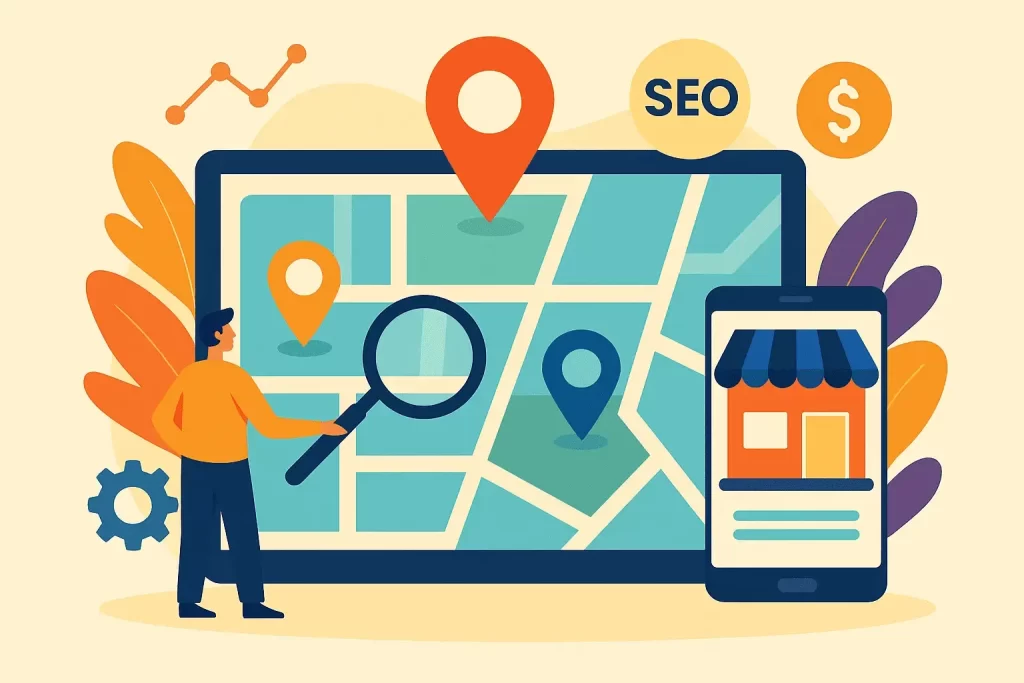Suppose you run a service-based business that travels to customers instead of welcoming them at a storefront. In that case, you’ve probably asked, How do I compete in Google’s local search results, especially if I don’t have a physical business address? The good news is that, in 2025, local SEO for service area businesses is not only possible but also essential for capturing high-intent leads and staying ahead of competitors who are slow to adapt. Understanding the local on-page SEO impact—such as optimizing landing pages, schema markup, and hyperlocal content—plays a key role in improving your visibility. Partnering with a reliable local SEO agency can help you implement the right local SEO strategy for businesses to show up in Google Maps and local packs, even without a storefront.
The Evolution of Service Area Business (SAB) SEO
Service area businesses, such as plumbers, electricians, cleaning services, landscapers, HVAC technicians, and mobile pet groomers, face unique challenges. Unlike traditional brick-and-mortar shops, SABs operate within a defined region and often do not have a public office for customers to visit.
Historically, Google favored physical addresses in local results. But over the past decade, policy and algorithm updates have slowly leveled the playing field. As of 2025, Google now recognizes that a large share of local commerce occurs on-site at the customer’s home or business, rather than at a storefront.
How Google Handles Service Area Businesses in 2025
Today, Google Business Profile (GBP) offers an optimized pathway for Small and Medium-sized Businesses (SABs) to appear in local packs and maps, even without displaying a public address. When setting up your GBP, you can choose to hide your physical address and instead specify your target service areas, whether by city, county, zip code, or region. For detailed instructions on managing your service areas within your profile, refer to Google’s official guidelines here.
Google relies on entity recognition, verified service area data, consistent NAP (Name, Address, Phone) details, reviews, and proximity signals to determine your local relevance.
Step-by-Step Guide: Local SEO for Service Area Businesses
Step 1: Set Up and Optimize Your Google Business Profile
Start by claiming your Google Business Profile (GBP)—the foundation of local SEO for service area businesses. Once claimed, be sure to follow Google Business Profile optimization best practices to set it up for maximum visibility.
- Select the option that indicates you deliver goods or services directly to customers.
- Hide your physical address if you don’t have a location open to the public.
- List all your service areas (cities, towns, or zip codes) accurately to match your actual business reach.
- Use a business email that matches your website domain for faster verification.
Pro Tip: Upload authentic, high-quality photos of your work, team, and branded vehicles to establish trust and credibility.
Step 2: Consistent NAP and Entity Data Everywhere
Google rewards businesses that provide consistent Name, Address (if listed), and Phone number (NAP) data. For service area businesses, ensure your NAP details are identical across your website, directories, and all local listings, even if the address is hidden.
- Update information on industry directories, social platforms, and review sites like Yelp, Angi, Facebook, and Nextdoor.
- Avoid abbreviations or spelling variations. Every entity reference should match, including phone numbers and hours.
Step 3: Build Localized, Service-Driven Website Pages
Your website is a powerful local SEO asset.
- Create a unique landing page for each service you provide (e.g., “Emergency Plumbing” or “Deep Cleaning”).
- Build pages for each core service area or neighborhood, writing natural, helpful content focused on local pain points.
- Use schema markup (LocalBusiness, Service, Review) to help Google understand your business model.
Example: “HVAC Repair in Downtown Dallas” should mention local neighborhoods, landmarks, and customer questions.
Step 4: Collect and Showcase Customer Reviews
Reviews influence your Google rankings and shape trust.
- Understanding how reviews influence your Google rankings and shape trust is key. Therefore, you should always ask every satisfied client to leave a Google review and on other major platforms. Respond to reviews with personalized, sincere messages that reference the service or location when appropriate.
- Never buy fake reviews. Google’s systems are more advanced than ever and can detect manipulation.
Bonus: Feature top reviews on your website with the reviewer’s first name and location, if possible.
Step 5: Create Hyperlocal Content and Answer Local Questions
Blog posts, FAQs, and project spotlights with local context build relevance and trust.
- Share stories from recent jobs, highlight unique challenges, or answer questions that come up in your target areas.
- Write about community events, local regulations, or seasonal trends relevant to your audience.
- Use headings and keywords naturally: “What to do if your pipes freeze in Toronto,” “Best cleaning tips for Miami humidity,” etc.
Step 6: Use Structured Data Markup for Every Service Area
Add structured data (schema) to every key page on your website.
- Tag your service areas, core services, customer reviews, and even business types.
- This makes your site easier for Google to index and connect with local search queries that align with your business’s intent.
Step 7: List Your Business on High-Authority Local Directories
Even without a storefront, you can boost credibility by being listed on:
- HomeAdvisor, Thumbtack, Angi, Houzz (for contractors and home services)
- Local Chamber of Commerce and Business Association sites
- Niche directories specific to your trade or service
Be sure to use the same business information and never leave fields blank.
Step 8: Leverage Google Posts and Messaging
Regularly post updates, offers, and educational tips on your Google Business Profile.
- Announce seasonal promotions, safety updates, or new services.
- Enable messaging and respond quickly. Fast replies are a positive ranking signal in 2025.
Step 9: Monitor Insights and Track Results
Check Google Business Profile insights monthly:
- See where your traffic is coming from, what actions customers take, and which photos or posts get attention.
- Use geo-grid ranking tools to track how you perform in different neighborhoods or zip codes.
- Adjust your content and service areas as you notice trends and opportunities.
Step 10: Build Local Backlinks and Partnerships
Google values businesses that are referenced and linked by other local, trusted entities.
- Partner with local charities, sponsor events, or collaborate with other service providers for joint promotions and mentions.
- Reach out to local bloggers or news outlets for coverage, testimonials, or interviews.
Every genuine mention reinforces your authority and local relevance.
Overcoming Common SAB SEO Challenges
- Verification without a storefront: Use your actual business location for verification (not a P.O. Box or virtual office), then hide the address. Never use a fake address; it risks suspension.
- Ranking in multiple cities: Build out individual pages and local content for each city or neighborhood. Avoid “doorway pages”—instead, add value with unique content.
- Competing with established businesses: Focus on reviews, responsiveness, and high-quality service. New SABs can outrank older listings with better engagement and reputation.
Advanced Tactics for 2025: Take Your Service Area SEO Further
- Geo-grid rank tracking: Use tools to check how you rank in different neighborhoods.
- Local backlinks: Get listed in local blogs, sponsorships, and event sites to build local authority. If you’re looking to strengthen your domain’s authority and rankings, explore link building services designed to deliver high-quality, relevant backlinks that support your local SEO efforts.
- Google Business Profile attributes: Fill out every relevant attribute, from “24/7 emergency service” to “eco-friendly solutions.”
- Voice search optimization: Many local searches in 2025 start with “Hey Google, find a… near me”—write content that answers these voice queries.
Why Local SEO for Service Area Businesses Matters Now More Than Ever
Consumers expect fast, local results, especially for urgent needs. If you’re not showing up when and where people are searching, you’re handing business to your competitors. Local SEO is the bridge that puts you in front of high-intent customers, even if your office is your van or your living room.
Measuring Success in SAB SEO
Track:
- Number of Google calls and messages
- Website visits from local pages
- Conversion rate on contact forms
- Review volume and quality
- Rankings across your target neighborhoods
Regularly optimize your profiles and pages based on this data.
Final Thoughts
Local SEO for service area businesses has undergone significant evolution. In 2025, you don’t need a physical storefront to win local customers; you need a smart, holistic strategy built on trust, real engagement, and technical optimization. Embrace these steps, keep learning, and your business can thrive in every zip code you serve.

